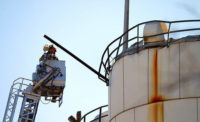Detecting dangerous combustible dust
Know how to measure levels, mitigate risks & comply with standards to avoid explosions






Manufacturing locations can be dirty, dusty environments by nature, depending on what is produced in a given location. As a result, many manufacturers are no stranger to airborne dust and the health hazards it can pose to workers regularly exposed to it.
While inhalation-related respiratory risks are often accounted for with personal protection equipment, a more immediate danger can sometimes be overlooked: the possibility of dust-derived explosions. At-risk facilities include not only manufacturing locations processing obviously combustible materials, such as coal dust, but any workplace that generates dust.
With proper controls, combustible dust explosions and fires are preventable. It’s important to know how to detect dangerous dust levels and mitigate the risks they pose to ensure worker and bystander safety. This article will lay out answers to frequently asked questions (FAQ) about combustible dust to help you know how to identify risks, comply with standards and create a safer environment.
Where does combustible dust come from?
Combustible dust is created when materials are transported, handled, processed, polished, ground and shaped. Dust is also created by abrasive blasting, cutting, crushing, mixing, sifting or screening dry materials, as well as during processing of wet materials that causes build-up of dried residue. We see combustible dust often in production and processing environments related to:
- Agriculture (e.g., grain elevators, bins and silos)
- Chemicals (e.g., fertilizer)
- Food (e.g., candy, sugar, spice, starch, flour, feed)
- Metal powder processing or storage (especially magnesium and aluminum)
- Paper
- Pharmaceuticals
- Plastics
- Rubber (e.g., tire manufacturing)
- Textiles
- Tobacco
- Woodworking (e.g., furniture manufacturing)
How dangerous is combustible dust?
Dust explosions continue to be a persistent problem for many industries, and even highly trained individuals such as enforcement officials, insurance underwriters and company safety professionals often lack awareness of combustible dust hazards. A single metal dust explosion that occurred in Jiangsu Province, China, killed 75 people and injured another 185.1 According to the U.S. Chemical Safety and Hazard Investigation Board (CSB), “281 combustible dust incidents between 1980 and 2005 killed 119 workers, injured 718 others and extensively damaged industrial facilities.” Figure 1 gives further historical perspective on global dust explosions.2
What causes a combustible dust explosion?
A dust explosion can only occur when the following five factors are present:
- Fuel (in the form of combustible dust particles)
- Dispersion of the fuel (in the form of a dust cloud)
- Oxygen (in the form of air)
- Confinement of the cloud (in the form of a closed area)
- An ignition source (in the form of a spark or open flame)
Dust dispersion can be caused by processing (e.g., a dry filter being pulse cleaned) or as an after effect of a primary explosion’s blast wave that distributes dust before igniting it in a secondary explosion. In Figure 2, you can see how this occurs. A secondary explosion can be far more damaging than a primary explosion due to the area covered by ignited combustible dust.
What guidelines exist for appropriate control of combustible dust?
Specific regulations exist for certain industries, such as OSHA Grain Handling Facilities Standard 29 CFR 1910.272, but awareness training, good housekeeping practices, strong safety documentation for specific materials, and adoption of best practices for dust control—such as those laid out by the National Fire Protection Agency (NFPA)—should be in place to minimize risks posed by combustible dust.
How can combustible dust levels be effectively measured?
The only way to know if combustible dust levels are posing a hazard is to conduct measurements. Here are a few options to consider:
- Perform a walk-through survey using a hand-held sampling device (Figure 3) that gives real-time indication of dust concentrations. This is useful for determining the effectiveness of control measures such as local ventilation systems.
- Consider leaving air sampling pumps unattended with real-time sampling devices housed in durable portable cases on a short-term basis. The systems determine dust concentration using a gravimetric filter and a time-history profile, allowing issue identification.
- Deploy fixed, AC-powered solutions designed for continuous use in high-risk areas. Data from these devices can be made available remotely using a web-based interface, and they can provide real-time alerts via text message or email should limits be exceeded. Reports can easily be automatically sent to multiple users, allowing for quick intervention as needed.
- Be aware that instrumentation may need to be intrinsically safe or require a hot-work permit in some locations. Action thresholds should always be set at a fraction of the lower explosion limit (LEL) for the dust in question. Ensure that you speak to the relevant site manager or supervisor who has responsibility for risk assessment and permitting to be sure your setup is appropriate.
How should combustible dust hazards be communicated?
Do not rely on technical documentation to communicate the hazards of combustible dust explosions and ways to prevent them. Develop appropriate training to ensure all employees have a basic awareness of the hazards of dust explosions and the best way to mitigate those risks. Finally, be sure that parties responsible for measuring and analyzing combustible dust levels properly understand how to recognize dangerous levels and take appropriate actions when they do.
Sources
- How the Deaths of 75 Workers at a Chinese Factory Could Have Been ‘Easily Prevented’, The Nation. August 2, 2014.
- Dust Explosions: A threat to the process industries; Z. Yuan, N. Khakza, F. Khan, P. Amyotte. Institution of Chemical Engineers. June 26, 2016.
Looking for a reprint of this article?
From high-res PDFs to custom plaques, order your copy today!









